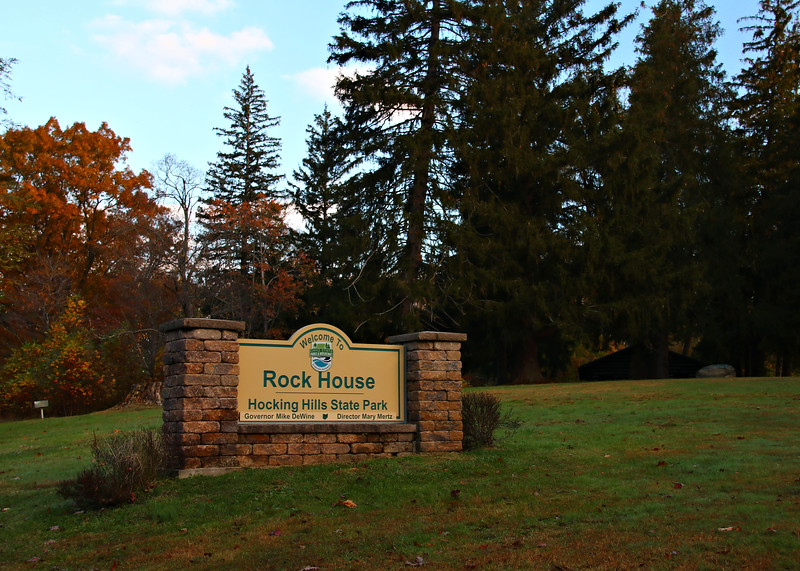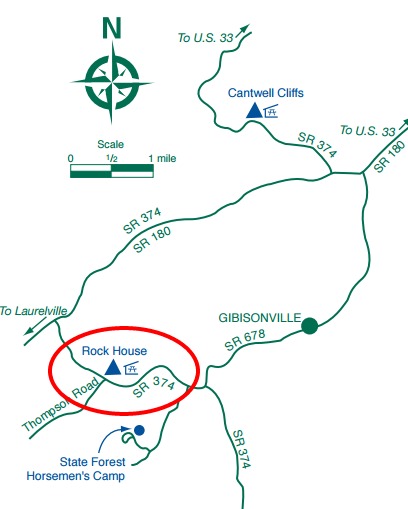Hocking Hills SP--Rock House

Hocking Hills SP--Rock House
Logan, Ohio 43138
Official WebsiteHocking Hills State Park Official Website
Hocking Hills State Park map
Hocking Hills trail maps
Athens Area Outdoor Recreation Guide Hocking Hills State Park
Also, see all the hotspots at:
Hocking Hills Important Bird Area
About this Location
Rock House is unique in the Hocking Hills’ region, as it is the only true cave in the park. It is a tunnel-like corridor situated midway up a 150-foot cliff of Blackhand sandstone.
This House of Rock has a ceiling 25 feet high while the main corridor is 200 feet long and 20 to 30 feet wide. The cavern was eroded out of the middle zone of the Blackhand sandstone. The resistant upper zone forms the roof and the lower zone forms the floor. Water leaking through a horizontal joint running parallel to the cliff face caused the hollowing of the corridor. This main joint or crack is very visible in the ceiling of the Rock House. A small series of joints run north to south at right angles to the main joint. Enlargement of this series of joints formed the window-like openings of Rock House.
About Hocking Hills State Park
See all hotspots at Hocking Hills State Park
The natural history of this region is as fascinating as the caves are beautiful. Here, in these sandstones and shales, one can read Ohio’s history from the rocks. The scenic features of the six areas of the Hocking Hills State Park complex are carved in the Blackhand sandstone. This bedrock was deposited more than 350 million years ago as a delta in the warm shallow sea which covered Ohio at that time. Subsequent millions of years of uplift and stream erosion created the awesome beauty seen today.
The sandstone varies in composition and hardness from softer, loosely cemented middle zone to the harder top and bottom layers. The recess caves at Ash Cave, Old Mans Cave, and Cantwell Cliffs are all carved in the softer middle zone. Weathering and erosion widened cracks found in the middle layer of sandstone at the Rock House to create that unusual formation.
Other features of the rock include cross-bedding, honeycomb weathering, and slump blocks. The first is noticeable as diagonal lines in the rock intersecting horizontal ones. It is actually the cross-section of an ancient sandbar in the delta and was caused by changing ocean currents. Honeycomb weathering looks like the small holes in a beehive comb. They are formed by differential weathering which comes about when water, moving down through the permeable sandstone, washes out small pockets of loosely cemented sand grains. Finally, the huge slump blocks of rock littering the streams tumble from nearby cliffs when cracks widen to the extent that the block is no longer supported by the main cliff.
Although the glaciers never reached the park areas, their influence is still seen here in the form of the vegetation growing in the gorges. The glaciers changed the climate of all of Ohio into a moist, cool environment. Upon their retreat, this condition persisted only in a few places such as the deep gorges of Hocking County. Therefore, the towering eastern hemlocks, the Canada yew, and the yellow and black birch tell of a cool period 10,000 years ago.
Notable Trails
The AllTrails website has a description and map of a hike to Rock House.
Features
Restrooms on site
Content from Official Website, Hocking Hills State Park Official Website, and Ohio Ornithological Society

